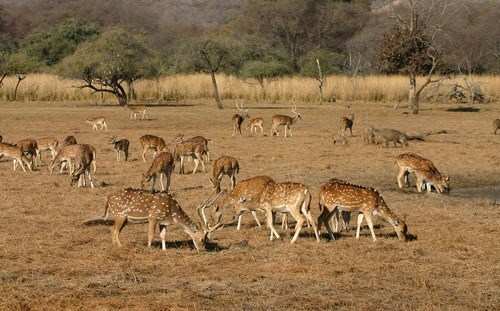Highways for Survival
Today, jungles and wildlife reserves exist in only isolated pockets and the animal species surviving within them face several threats. Inbreeding among animals in these isolated pockets is rampant, giving rise to a whole generation of inferior animals.

A paper written by Raza H. Tehsin. Published in Tigerpaper in 1998 wherein he gave this theory for the first time.
The Asiatic Lion (Panthera leo persica), once widely distributed in India from Sind to Bihar, was gradually exterminated by the turn of the century and is now confined to the Gir Forest of Saurashtra.
At about the same time, the wildlife equations in the country were rapidly changing with the decimation of large jungle tracks and conversion of jungles into agricultural lands, resulting in widespread destruction of animal habitats.
Species like the Asiatic Lion were confined to isolated pockets in relatively small jungle reserves and thus arose the threatening imbalance between the predator and the prey.
With the decimation of the Asiatic Lion from Central India, its chief prey animal, the Nilgai (Boselaphus tragocamelus), gradually grew in number to become a menace to both man and the delicate ecosystem.
It is roughly estimated that in Rajasthan state of India alone about 150,000 Nilgai roam destructively in the farms, zealously guarded by religious sentiments, presenting naturalists with all sorts of problems for which practical solutions are yet to be found.
It is an accepted fact that the rapid pace of human civilization and the provision of basic living facilities for the ever-expanding human population have eaten into the invaluable jungle resources.
Today, jungles and wildlife reserves exist in only isolated pockets and the animal species surviving within them face several threats. Inbreeding among animals in these isolated pockets is rampant, giving rise to a whole generation of inferior animals.
Certain species like the Asiatic Lion, the Great Indian Rhino and the Wild Buffalo have been confined to singular jungle reserves and are not seen elsewhere. Confinement further exposes the species to the grave threat of total extinction through epidemics, natural calamites or further destruction of the confined habitats.
Naturalists are desperately looking for alternative habitats but here again the basic problem remains unsolved – How can the animals be shifted to the chosen reserves? Will they survive there? Does the delicate fabric of the ecosystem permit artificial translocation of animals?
Before the advent of man on earth, the major part of the land was appropriately forested, teeming with innumerable species of animals. Large herds of these animals constantly moved in well-guided directions in search of food and water, regularly treading on the jungle undergrowth along chosen routes, thereby creating game-paths.

Due to adverse climatic conditions, over population, instinct or curiosity, the animals were forced to migrate to other suitable habitats. The naturally created game paths served as highways and made migrating conditions easy and comfortable. When man appeared on earth, he too utilized these game paths for hunting. In the search of new hunting grounds and better climatic conditions, man also followed the long distance game paths from one jungle zone to another, created by migrating wild animals.
Today, the best example of these game paths is goat tracks. If you want to climb a hill or low mountain, you have to follow the goat tracks that are less strenuous than climbing haphazardly on your own. When man progressed and mechanization developed, he broadened most of these game paths of the plains and hills to have way for vehicular traffic.
It is surprising that naturalists in their quest for practical solutions have overlooked the behavioral tendencies of animals. Migration, as discussed above, is one trait of animal behavior that can be reasonably exploited to solve one of the most acute problems faced by wildlife today.
Isolated jungle reserves can be effectively linked to other reserves by creating strips of jungles by planting trees, bushes and herbs alongside roads and paths leading out of these jungles to enable the animals to migrate under natural conditions.
Most animal species have lost their migratory instincts but these can be revived and specific animal species can be effectively induced to migrate on chosen reserves. This calls for concerted efforts but there is little doubt that this is the best and most practicable solution.
Once this is achieved, the problems of isolation and confinement of animal species, the spilling over of animals into human habitations and the grave danger of total extinction of animal species can be overcome. It is in such fruitful direction that naturalists must strive to work, for only nature can be used of to solve its own problems.
Published in Tigerpaper: Periodical of FAO (Food and Agriculture Organization) of the UN (United Nations):
Tehsin, R. H. (1998) Highways For Survival. Tiger Paper 25 (2): 26
Author’s Note: From this paper it is plain that animals too have a high skill of engineering. It is a blow to the ego of man that engineering is indigenous to him. Burrows of several mammals are a marvellous engineering feat. If you dig them out you will find excellent tunnels and chambers for rest, storage and escape. Several species of birds like Weaver Bird, Tailor Bird etc. that build complicated nests put us in awe. These are also marvels of engineering skills. Similarly beavers also build dams and are capable of changing environment of a particular place in a very short period like us. This paper shows how some complicated problems of wildlife can be solved by simple methods like giving corridors for migration. Now the naturalists have started to think in this direction.
Let us permit nature to have her way. She understands her business better than we do. ~Michel de Montaigne
To join us on Facebook Click Here and Subscribe to UdaipurTimes Broadcast channels on GoogleNews | Telegram | Signal


